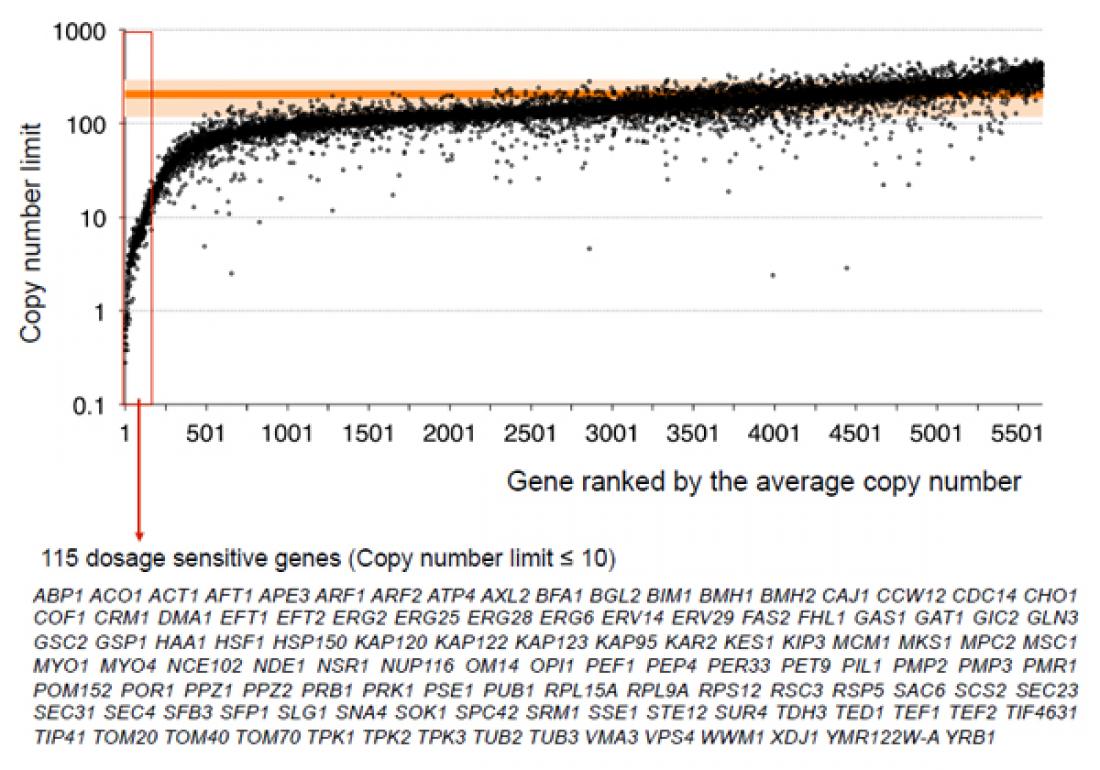Figure 1. Copy number limits of all genes in the budding yeast More than 80% of the genes have the copy number limits >100. On the other hand,there are 115 genes that have the copy number limits <10. The group named these genes "dosage sensitive genes".
Source: Okayama University, Planning and Public Information Division
(Okayama, Japan, 19 June 2013) Professor Hisao Moriya and colleagues at Okayama University used their ‘tug of war method to measure the copy number limits of all protein-coding genes in yeast—the first time ever for any organisms.
Over-expression of proteins due to the increase in the gene-copy numbers is considered to be the cause of pathologies of diseases such as Down syndrome and cancer, which involve chromosomal abnormality. However, the causal genes and thus the mechanisms directly involved in their pathologies are not clear, because gross rearrangements of the number of chromosomes, which contain a large number of genes, occur in these diseases.
The research group of associate professor Hisao Moriya previously developed an experimental technology designated "genetic Tug-Of-War (gTOW)" to measure how much the copy number of a gene can increase without disrupting the cellular function (the copy number limit of a gene).
The group uses the budding yeast Saccharomyces cerevisiae as the simplest model eukaryote, which basically has the same cellular structure as human cells. Using the gTOW method, the group recently has measured the copy number limits of all protein-coding genes (about 6000 genes) in S. cerevisiae, as the first time ever for any organisms (Fig.1).
As the result, the group first discovered that >80% of the genes have the copy number limits >100. This indicates that the cellular system is surprisingly robust against the increase in the copy numbers of most genes. The group also identified 115 genes with the copy number limits of 10 or less (here we designate these genes "dosage sensitive genes") (Figure 1 and Figure 2). Identified genes significantly contained genes involved in cytoskeletal organization and intracellular transport. They also tended to encode proteins relatively abundant in the cell, and proteins function as complexes with other proteins.
From these characteristics, the group assumed that the burden of the turnover of unnecessary proteins toward basic cellular functions (protein burden), and the dosage imbalance within protein complexes (stoichiometry imbalance) caused the strong adverse effects produced by the dosage sensitive genes. With additional gTOW experiments, the group further confirmed these assumptions were true. Finally the group proposed a hypothesis that the dosage balances of dosage sensitive genes determine the composition of chromosomes. The hypothesis explains how compositions of chromosomes of current organisms have been determined during evolution, and how they are stably maintained.
To understand what happens when the copy number of a dosage sensitive gene increases in yeast is to understand the pathologies of Down syndrome and cancer, in which the increase in chromosome numbers are involved. In addition, it is known that malignant cancer cells can avoid the adverse effects brought by the increase in the number of chromosomes. The group believes that the mechanisms to avoid the adverse effects are revealed by identifying the mutants that tolerate the copy number increases of the dosage sensitive genes in yeast.
Title: Identification of dosage-sensitive genes in Saccharomyces cerevisiae using the genetic tug-of-war method
Authors: Koji Makanae, Reiko Kintaka, Takashi Makino, Hiroaki Kitano, Hisao Moriya
Journak: Genome Research 2013 23(2) 300-311
Affiliation: Research Core for Interdisciplinary Sciences, Okayama University, Okayama 700-8530, Japan
http://tenure5.vbl.okayama-u.ac.jp/HMlab/
Further information:
Okayama University
1-1-1 Tsushima-naka , Kita-ku ,
Okayama 700-8530, Japan
Planning and Public Information Division
E-mail: [email protected]
Website: http://www.okayama-u.ac.jp/index_e.html
About Okayama University
Okayama University is one of the largest comprehensive universities in Japan with roots going back to the Medical Training Place sponsored by the Lord of Okayama and established in 1870. Now with 1,300 faculty and 14,000 students, the University offers courses in specialties ranging from medicine and pharmacy to humanities and physical sciences. Okayama University is located in the heart of Japan approximately 3 hours west of Tokyo by Shinkansen.
Website: http://www.okayama-u.ac.jp/index_e.html
Fig. 2. Interactions of 115 dosage sensitive genes identified in this work 115 dosage sensitive genes significantly contain genes involved in cytoskeletal organization and intracellular transport. The increase of these genes cause cellular dysfunction due to "protein burden" and "stoichiometry imbalance".




